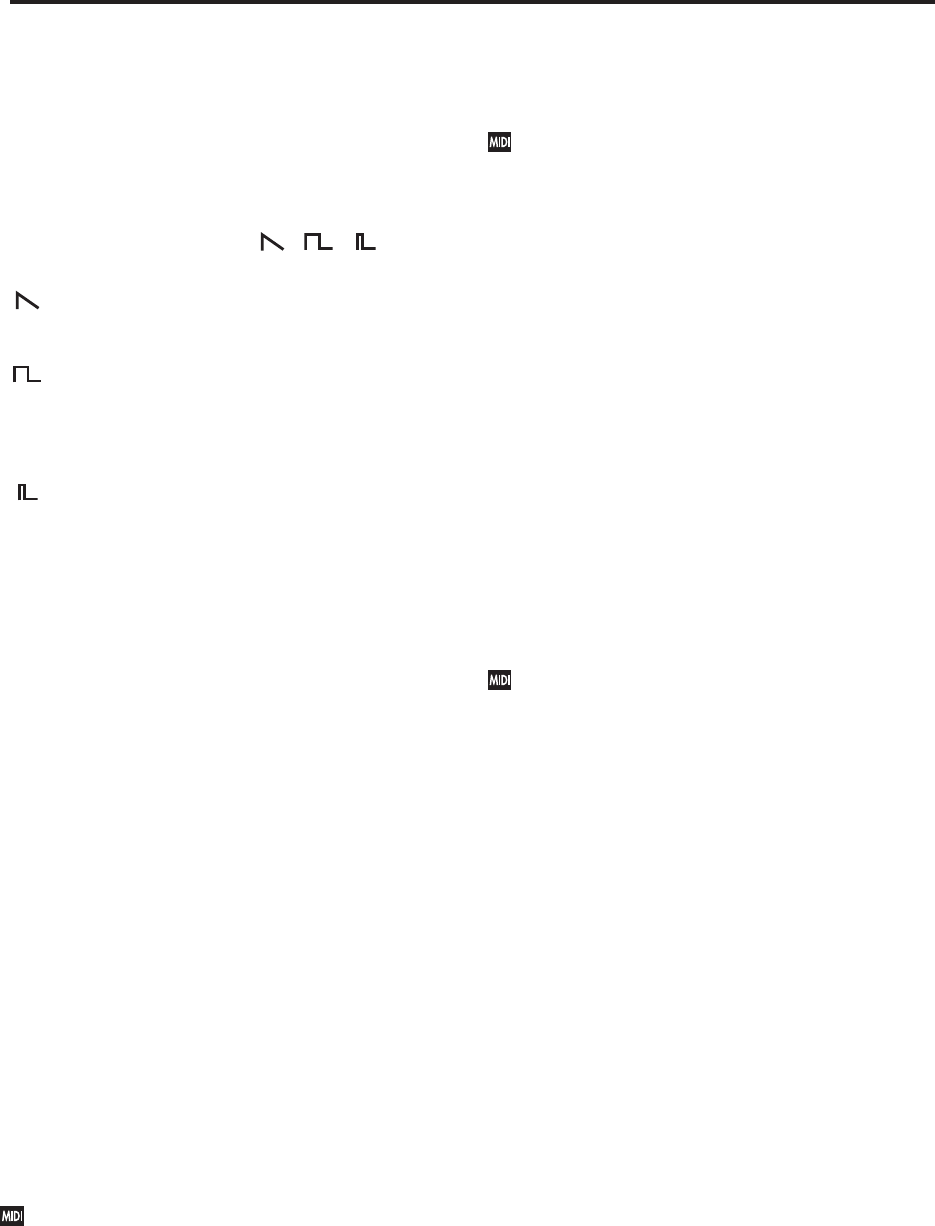
EXi: MS-20EX
286
SCALE [32’, 16’, 8’, 4’]
Adjusts the pitch of Oscillator 1 in steps of an octave.
With each halving of the “feet” value, the pitch goes up
one octave. For example, 4’ is one octave higher than
8’, and 16' is one octave lower that 8'.
VOLTAGE CONTROLLED OSCILLATOR 2
WAVE FORM [ , , , RING]
This sets the basic timbre of Oscillator 2.
(Sawtooth): This produces the traditional, buzzy
analog synth sound. For more information, see “WAVE
FORM” on page 285.
(Square Wave): This is a hollow-sounding
waveform, containing only odd-numbered harmonics
present. The original MS-20 manual notes that this is
used to “simulate reed instruments and other closed
pipe sounds.”
(Pulse Wave): This is a relatively narrow pulse
waveform, with a nasal tone quality and strong upper
harmonics. The original MS-20 manual suggests that it
be used to “simulate double reed instruments (e.g., the
oboe) and certain plucked string sounds (e.g.,
harpsichord and clavinet).”
RING (Ring Modulator): This setting combines the
two VCOs to create sums and differences of all their
harmonics, creating a complex tone. The original MS-
20 manual describes it this way: “The result is a
clangorous, “metallic” sound which is useful for gong,
chime and other such effects. VCO 1 and VCO 2
SCALE, PITCH, and PW all affect the resulting sound,
and should be used judiciously to create the desired
effect.”
PITCH [–12.00…+12.00]
This adjusts the pitch of Oscillator 2 up and down by
one octave, in one-cent steps. You can create thicker
sounds by moving this slightly away from 0.00, so that
the two oscillators beat against one another.
SCALE [16’, 8’, 4’, 2’]
This adjusts the pitch of Oscillator 2 in steps of an
octave. Note that the range is one octave higher than
that of Oscillator 1.
PORTAMENTO
TIME [0.00…10.00]
This controls the amount of time it takes to glide from
one pitch to the next.
This is scaled by MIDI CC#5. You can also enable
and disable Portamento using MIDI CC#65
(“Portamento Switch”).
Assigning SW1 or SW2 to Portamento On/Off
You can use the two assignable switches, SW1 and
SW2, to turn portamento on and off.
To do so:
1. Go to Program page 1-8, Controller Setup.
2. Under Panel Switch Assign, set either SW1 or SW2
to Portamento SW (CC#65).
Now, the selected switch will enable and disable
Portamento. It will also send the MIDI Portamento
controller, CC#65.
Even if you don’t assign SW1/2 to Portamento, you
can still use MIDI Controller #65 to turn Portamento
on and off.
FINE TUNE
FINE TUNE [–5.00…+5.00]
This adjusts the pitch of the oscillators, in steps of 1/5
of a cent (for a total range of +/- 1 semitone).
FREQUENCY MODULATION
Each of the FREQUENCY MODULATION controls
affects both VCO 1 and VCO 2.
MG/T.EXT [0.00…10.00]
If nothing is connected to the patch panel’s TOTAL
input jack, this adjusts the depth of pitch modulation
from the MG’s Triangle Wave.
If a cable is connected to the TOTAL input jack, this
controls the depth of pitch modulation from that
signal.
For more information, see “TOTAL input jack” on
page 295.
This is scaled by MIDI CC#77.
EG1/EXT [0.00…10.00]
If nothing is connected to the patch panel’s FREQ jack,
this controls the depth of pitch modulation from EG 1.
If a cable is connected to the FREQ jack, this controls
the depth of pitch modulation from that signal.
With nothing connected to the FREQ jack, try
increasing the EG1/EXT value, and then play a note on
the keyboard. Notice that the pitch of the note rises
and falls corresponding to EG 1’s DELAY, ATTACK,
and RELEASE controls.
With the normalled connection to EG1, the pitch
always starts low, rises to the played note, and then
falls again on release. The setting of the EG1/EXT knob
determines the low point of this modulation, while the
high point stays constant.
You can create a different effect by manually patching
the EG1 OUT jack into the FREQ jack. In this case, the
pitch will start at the played note, rise up to the
EG1/EXT setting, and then fall back to the played note.
VCO Mixer
This mixer controls the levels of the two VCOs into the
Highpass Filter.
Note that both filters will show some amount of
saturation and overdrive when their input levels are
high, and PEAK settings are moderate or high. You can
control the resulting tone by rasing or lowering the
VCO levels in this mixer.
VCO 1 LEVEL [0.00…10.00]
This adjusts the volume of Oscillator 1.
VCO 2 LEVEL [0.00…10.00]
This adjusts the volume of Oscillator 2.


















